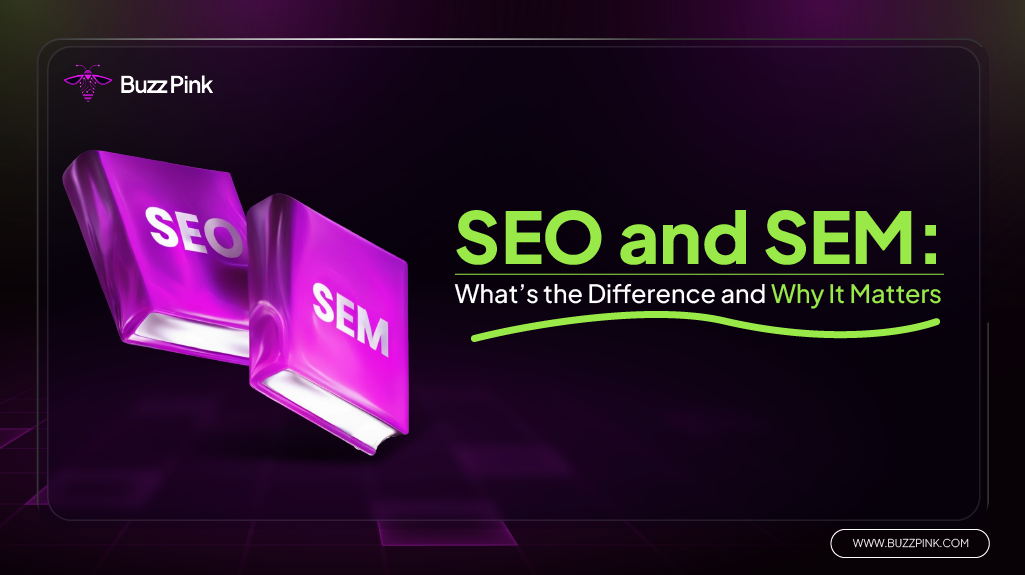Before ChatGPT was a thing, search engines like Google, and sometimes Bing, were your number 1 go-to to seek answers. And no, you weren’t immediately served the answers you want. To find the articles that addressed your questions, you actually needed to enter the right keywords.
That is what we call SEM. By showing all of the answers on the first page, search engine marketing helped you find the answers quickly and effectively without having to spend all day digging. Through SEM and SEO, the articles are optimized to benefit both the business owners and the audiences.
What Are SEO and SEM?
 Search Engine Optimization (SEO) is a technique to optimize your website so that it will naturally show up on the first page. It is well-known for its organic approach and outcomes, so you won’t be charged for continuously rubbing ads to your audience because it is free.
Search Engine Optimization (SEO) is a technique to optimize your website so that it will naturally show up on the first page. It is well-known for its organic approach and outcomes, so you won’t be charged for continuously rubbing ads to your audience because it is free.
On the other hand, SEM is an umbrella term that covers both SEO and PPC. Many people mistakenly believe that SEM is the antithesis of SEO, but it’s actually PPC. The SEM technique known as “Pay-Per-Click” requires payment to appear on the first page, and it is paid every time a user clicks on it. When a keyword is searched and the terms “sponsored” or “ad” appear alongside the article title, that’s PPC.
Read More: Top 10 SEO Agencies in Singapore for You to Consider in 2025
To put it clearly, SEM is the umbrella for the entire marketing concept, including SEO and PPC. Since SEM covers both, you would receive treatment for both PPC and SEO when you paid for it. However, if you want an organic approach, a particular SEO service is the solution.
Why SEO and SEM Matter in Today’s Digital Landscape
 In today’s highly competitive digital space, having a strong online presence is essential for any business. SEO and SEM play a significant role in helping brands become more discoverable and relevant to their target audience. These strategies not only increase visibility but also support business growth by driving traffic, generating leads, and improving conversion rates.
In today’s highly competitive digital space, having a strong online presence is essential for any business. SEO and SEM play a significant role in helping brands become more discoverable and relevant to their target audience. These strategies not only increase visibility but also support business growth by driving traffic, generating leads, and improving conversion rates.
SEO focuses on building long-term credibility. By optimizing your website’s content, structure, and authority, you gradually improve your position in search engine rankings. Over time, this leads to consistent, organic traffic without relying on paid efforts. It also signals to search engines that your content is trustworthy and relevant, which contributes to sustained visibility.
SEM, on the other hand, allows you to gain immediate traction through paid campaigns. By targeting specific keywords and audiences, you can appear at the top of search engine results and attract potential customers right away. This is extremely effective for time-sensitive campaigns, product launches, or competitive markets where instant fame is needed.
When used together, SEO and SEM provide a well-rounded approach to search marketing. SEO supports sustainable growth, while SEM delivers fast results. Integrating both strategies helps ensure that your business remains visible throughout every stage of the customer journey, from awareness to decision-making.
Types of SEO and How They Work
SEO is not just about writing articles and hoping they go viral, and boom! You’re on the first page. There are numerous technical and strategic techniques to consider in order to get Google to like your website. The strategies are summarized into four primary parts: on-page SEO, off-page SEO, technical SEO, and user interaction signals.
Each type plays a unique role in helping your site rank better, and they all work together like puzzle pieces. Mastering even just one can make a difference, but combining them? That’s how you really catch Google’s attention.
-
On-Page SEO
On-Page SEO focuses on the content and structure of the pages on your website. For example, you should use keywords that people often search for in the title, URL, and content of the article. This helps Google understand the main topic of your page. You should also use headings and, if necessary, insert images to create a neat writing structure.
-
Off-Page SEO
It’s about how other websites recognize your website. One strategy is to build backlinks, which are links from other business websites that lead to the one you run. The more high-quality backlinks your website has, the more important it is to Google. Social media activity and user feedback are also taken into consideration.
-
Technical SEO
Technical SEO ensures that search engines can read your website with ease. Pages, for example, should be quick to load, have a responsive design that works on both mobile and laptop devices, and contain no broken links. You should also create a sitemap and use data structures to help Google understand your content better.
-
User Interaction Signals
Google also monitors how visitors interact with your website. If a high percentage of visitors leave without clicking anything (bounce rate), it indicates that your page is not that relevant. However, if they continue to click here and there, Google will consider your page useful.
How SEM and PPC Work on Search Engines
As previously stated, SEM includes SEO, but what distinguishes it is the paid component, PPC. The tricky part is that paying for advertisements does not guarantee that you will appear on the first page of results. There are some factors to consider if you want it to work effectively and not waste your money.
Starting with bidding on the relevant keywords to writing captivating ad copy, every little thing matters. Search engines also evaluate the quality of your ad and landing page, not just how much you’re willing to spend. So yes, money helps, but strategy is what actually gets you seen.
-
Bidding System
You can set a bid for a specific keyword. For example, if you sell perfume, you can bid a price of, say, $3.00 for your website to appear when someone searches for the keyword “floral perfume.” That also means that every time someone clicks on your website, you’re required to pay $3.00. The greater the budget you propose, the bigger the probability of your ad being featured at the top of listings.
But bidding isn’t just about throwing the biggest number at Google and hoping for the best. It’s also about understanding how much a keyword is worth to your business. If each customer brings in $100 in profit, spending $3 per click might be a great deal. If not, you’ll need to rethink your bid strategy or focus on more affordable keyword options.
-
Quality Score by Google
Another thing to keep in mind is that Google considers not only the amount you pay but also how well your ad matches what users are looking for. This value, known as Quality Score, is influenced by the ad’s quality, the landing page, and how frequently people click on your ad (CTR). Logically, if what you offer does not match the keyword, visitors will leave the page. So you might want to think about that.
A high Quality Score can actually let you outrank competitors who bid more than you. That’s because Google wants users to have a good experience, not just show the highest-paying ad. So the more helpful and relevant your ad and landing page are, the more Google will reward you with better placement and lower costs.
-
Creative Ad Copy
You simply don’t slap relevant keywords and call it a day. You need to make it more interesting so that people will click. Good ad copy actually increases your Quality Score, which means less money per click. So, if you’re confident in your ability to create creative ad copy, you don’t have to bid high.
Great ad copy speaks directly to what users want by giving them fast solutions, limited-time offers, or even just clear benefits. The difference between “Buy now” and “Shop limited edition floral perfumes today” could be the difference between getting scrolled past or clicked. Don’t underestimate the power of words that connect and convert.
-
Account Management
So, PPC isn’t just about paying, and you suddenly get a flood of visitor clicks. It also requires strategic planning. You have to assess which keywords are most favorable, generate a variety of keyword suggestions, and adjust the budget accordingly. To avoid wasting money, this requires ongoing practice and analysis.
In practice, this means constantly checking your metrics: Which ads are performing? Which keywords are eating your budget without results? Do certain times of day work better than others? Managing an ad account well takes regular attention, but if done right, it can lead to consistent, high-quality traffic that pays off.
The Differences Between SEO and SEM
SEO and SEM are clearly distinct, as SEO is entirely organic, whereas SEM involves PPC, which requires payment. Furthermore, they differ in terms of long-term results and investment fees.
Both have their own strengths and use cases, which is why understanding these differences is key before deciding where to put your time and budget. Knowing when to use which can make or break your marketing strategy.
-
When to See Results?
SEO is like planting a tree. You must be patient because the results do not appear immediately. Your pages may take 3-12 months to appear on Google’s first page, particularly if your website is new. In fact, according to one analysis, the majority of the results are only visible after two years. The websites at the top of Google’s search results are typically 3-5 years old. However, once you’ve achieved success, you can continue to attract visitors without paying again.
SEM through PPC is similar to purchasing gasoline for a motorcycle. After you pay, your website will go live and begin receiving visitors immediately. However, if you stop paying, everything will stop immediately as well. This marketing technique is appropriate for short campaigns or limited promotions, but it is not effective for the long term.
-
Return on Investment
SEO is indeed free because you’re not required to pay every time a visitor clicks. However, you still need initial capital. To create an article that would land on the first page organically, you need to brainstorm the topics, endlessly analyze various keywords, continuously adjust the article, and sometimes you even need to pay extra for a web designer or web developer.
So, yes, you still have to pay to make everything work, and not just with money, but also time. Additionally, you must keep tabs for at least 6 months to view the end results. However, once you’ve achieved your goals and landed on the first page, you won’t have to worry about long-term ROI because SEO has you covered.
On the other hand, the PPC technique will show you results within a day. Not a significant one, but it will show results immediately because your page will be at the top of the front page, so visitors will definitely see it and will most likely click.
Despite its speed and convenience, you must exercise caution when it comes to budget management. Assume that a large number of visitors click on your page, but it is not relevant to their search. In this case, you will simply be burning money with no return on investment. There are no lingering visitors and no new customers. You’re just getting flooded with meaningless clicks.
How to Decide Between SEO and SEM
 When you have a limited budget but want long-term results, SEO services may be worth considering. Furthermore, if you are confident in producing informative articles that many people are looking for. Beyond that, if you understand how to obtain backlinks from other websites, and finally, if you are patient and don’t mind waiting several months for results.
When you have a limited budget but want long-term results, SEO services may be worth considering. Furthermore, if you are confident in producing informative articles that many people are looking for. Beyond that, if you understand how to obtain backlinks from other websites, and finally, if you are patient and don’t mind waiting several months for results.
SEM PPC is appropriate for achieving immediate results, such as launching a product or running a short-term campaign. In addition, you must have a fixed monthly advertising budget, understand how to set up a Google Ads account, and have a large number of landing pages that can be tested and optimized.
Benefits of Optimizing SEO and SEM
If you have a large enough team and resources, consider doing both SEO and SEM. Optimizing the two marketing strategies can help you achieve your objectives not only faster, but also in the long run.
Read More: Top 10 SEM Agencies in Singapore to Boost Your Business in 2025
While SEO builds a strong organic presence over time, SEM allows you to capture immediate attention through targeted ads. By combining both, you can cover all stages of the customer journey from awareness to conversion, ensuring your brand stays visible, competitive, and consistently relevant in search results.
-
Broader Range of Visibility
SEO can help you appear in organic search, while SEM helps you appear directly at the top of the Google page. The combination of these two makes your brand easier to find, reaching both users who are browsing naturally and those ready to click on targeted ads.
-
Broader Keywords Coverage
SEO allows you to target informative keywords so that visitors who are simply curious can read for a brief period. Meanwhile, SEM allows you to directly target more specific keywords for visitors who are ready to purchase. As a result, you can reach all levels of visitor searches.
-
More Data to Evaluate
Optimizing both SEO and SEM strategies can provide you with valuable information. More comprehensive data can assist you in determining which keywords are most effective, which ads receive the most clicks, and which articles are read the most. All of which can assist you in making more informed decisions.
-
Additional Traffic
SEO can provide consistent traffic, whereas SEM can provide additional traffic via advertisements. The combination of SEO and SEM has the potential to increase both sales and brand awareness.
Conclusion
Choosing between SEO and SEM isn’t always about picking one over the other. It’s about understanding your current goals, your available resources, and how quickly you need results. SEO gives you stability and sustainable profits, while SEM offers rapid growth and adaptability. When done right, both can complement each other.
If you have the capacity to run both, you’re setting yourself up for success on two fronts. You can reach people at different stages of their search journey, collect more meaningful data, and maximize your chances of being seen. So, whether you’re aiming for instant visibility or steady growth, combining SEO and SEM can help your business stay competitive and relevant in today’s fast-paced digital world.
Kamila Putri is a content strategist and digital marketing expert who helps brands craft messages that resonate and drive results. With a strong foundation in SEO, brand voice, and data-driven strategy, she has produced content that performs, whether it's optimized web copy, lead-generating campaigns, or conversion-focused messaging. At Buzz Pink, she applies this expertise to help clients grow through smart, search-focused digital strategies that engage, inform, and convert.


